Ancient India Art
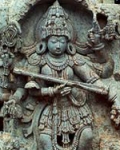
The visual Art of India starting from 3rd millennium BC can be classified into specific periods.
This classification could be based on religious, political and cultural developments in India during different historical period of ancient India.
Arts in the Indus Valley Civilization
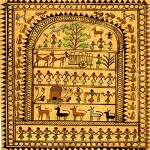
Indus Valley Civilization
There is ample evidence of Arts from various sculptures, seals, pottery, gold jewellery, terracotta figures that has been excavated from the sites of Indus valley civilization. It has been found that people of Indus civilization were great lovers of the fine arts, particularly of dancing, painting and sculpture. Their works of Indus art indicate that they had fine artistic sensibilities and their Art was highly realistic, considered much advanced for their time period.
The most conspicuous part of the Indus Art is the anatomical details that are noted for its extremely careful modelling of animal figures.
Their terracotta art is also unique for this purpose. Sir John Marshall who discovered many Indus cities reacted with surprise when he saw the famous Indus bronze statuette of the slender-limbed "dancing girl" in Mohenjo-daro.
He said; when I first saw them I found it difficult to believe that they were prehistoric; they seemed to completely upset all established ideas about early art. Modeling such as this was unknown in the ancient world up to the Hellenistic age of Greece, and I thought, therefore, that some mistake must surely have been made; that these figures had found their way into levels some 3000 years older than those to which they properly belonged.
Now, in these statuettes, it is just this anatomical truth which is so startling; that makes us wonder whether, in this all-important matter, Greek artistry could possibly have been anticipated by the sculptors of a far-off age on the banks of the Indus."
Indus people loved the art of dancing. The bronze, terracotta, and stone sculptures in dancing poses reveal this facet of their lives. They were also found of music. The people of Indus used stringed musical instruments. This is confirmed from a harp-like instrument depicted on an Indus seal and two shell found from the Lothal site in Rajasthan.
Indian rock-cut architecture
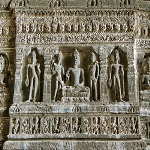
Indian rock-cut architecture
The earliest tradition of rock cut architecture is to be found in the artistic monuments related to Buddhism. The Buddhist art first developed around the 1st century BCduring the Gandhara period and Amaravatiperiods.
It greatly flourished during the Gupta periods and the Pala periods that comprise the Golden Age of Arts in India Subsequently,the Hindus and Jains too imitated the Buddhist rock cut style. Empires like the Pallava, Chola, Hoysala and Vijayanagaradeveloped their own styles rock-cut architecture.
Badami, Aihole, Ellora, Salsette, Elephanta, Aurangabad and Mamallapuram are some of the examples of rock-cut architecture. The rock-cut temples continued to be excavated until the 12th century.
Shore Temple, Mahabalipuram
The construction of free-standing structures began in the 5th century. An example of a free-standing structuralis the Shore Temple at Mahabalipuram with its slender tower. It’s built with finely carved granite rocks cut like bricks and dating from the 8th century.
Bronze sculpture
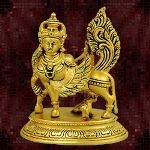
Bronze sculpture
The Chola period is also remarkable for its bronze sculptures. The fine figures of Siva in various forms, Vishnu and his consort Lakshmi, Siva saints and other bronze sculpture found among the existing specimens ofChola period are found in the temples of South India. The bronzes sculpture was created during Cholaperiod using the lost wax technique. It is known in artistic terms as "Cire Perdue".
Indian fresco
The evidence of Indian fresco dates back to Mesolithic period (6000 BCE). The early example of fresco art could be found making use ofrock-cut art in natural caves that had overhanging rock decorations. There are multiple locations of fresco art found dating back to prehistoric times.
Rock Shelters of Bhimbetka
The Rock Shelters of Bhimbetka, a World Heritage Site, are on the edge of the Deccan Plateau, an example of earliest Indian fresco. Many caves and grottos found there contain decorative rock paintings that reflect the ancient tradition of human interaction with their landscape.
Ajanta Caves
The Ajanta Caves, 2nd century BC is the oldest frescoes of ancient India that has been preserved till now. There are more than 20 locations with paintings and traces of paintings of ancient and early medieval India dating up to 10th centuries AD. The most significant frescoes of the ancient and early medieval period are found in the Ajanta, Bagh, Ellora, and Sittanavasal caves.
Chola fresco
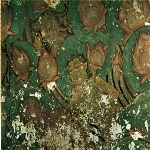
Indian frescoThe first specimen of Chola fresco paintings were discovered at the Brihadisvara temple in 1931. They probably synchronised with the completion of the temple by RajarajaCholan the Great. Researchers say that in Chola fresco a smooth batter of limestone mixture was applied over the stones.
This technique took two to three days to set and within that period, such large paintings were painted with natural organic pigments.. The Chola frescoes have an ardent spirit of Saivism expressed in them. During the Nayak period the Chola paintings were painted over.
The tradition of fresco art is also found in Kerala mural paintings. The mural paintings are well preserved on the temple walls at Pundarikapuram, Ettumanoor and Aymanam and elsewhere.
Folk and Tribal Art
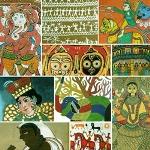
Indian frescoThe Folk and Tribal art of Ancient India is manifested through pottery, painting, metal work, paper-art, weaving and designs of jewellery and toys. These are not merely aesthetic objects but play a significant role in people's lives and are connected to their beliefs and rituals. The objects can range from sculpture, masks, paintings, textiles, baskets, kitchen objects, arms and weapons etc.
There is a deep symbolic meaning attached to not only the objects but also the materials and techniques used to produce them.
The visual expressions of Folk art also include the wandering nomads, who are exposed to changing landscapes as they travel over the valleys and highlands. They carry with them the experiences and memories of different spaces and their art consists of the transient and dynamic pattern of life. The rural, tribal and arts of the nomads constitute the matrix of folk expression.
Fairs, festivals, local heroes (mostly warriors) and local deities play a vital role in these arts. Examples of folk art are to be found in Warli, Madhubani and Gond paintings.
Contribute More Facts